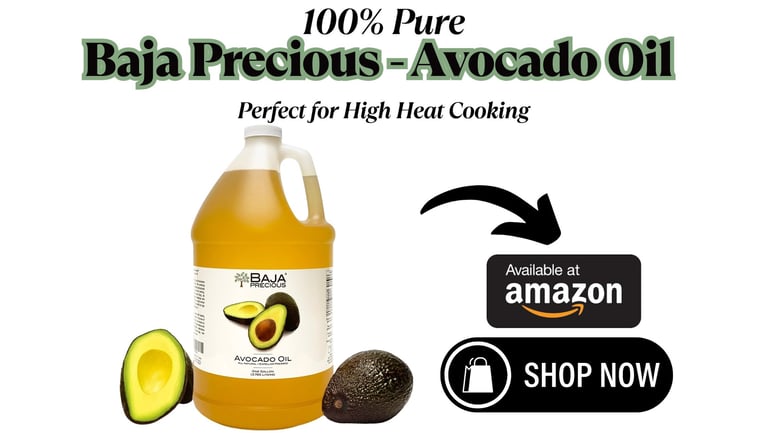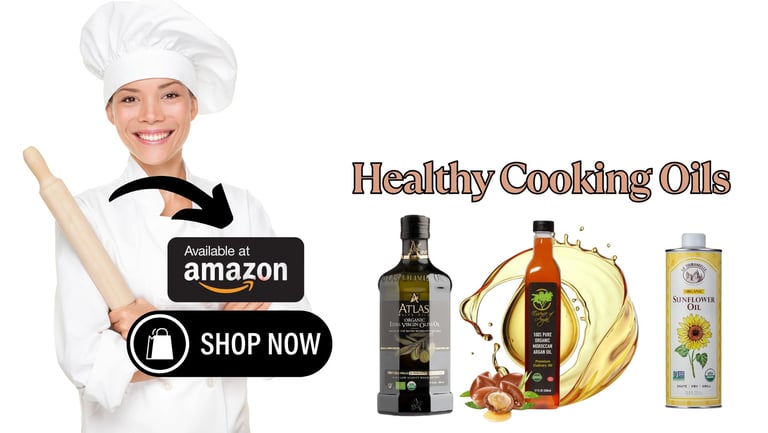How to Choose Best Oil for Cooking: Guide for Health and Flavor
Find out how to choose best oil for cooking, with facts on smoke points and taste so your meals stay healthy and delicious.
KITCHEN TIPS & TECHNIQUES
Shari Smith
7/7/202512 min read
This post may contain affiliate links, and I may earn a commission if you choose to make a purchase through them.
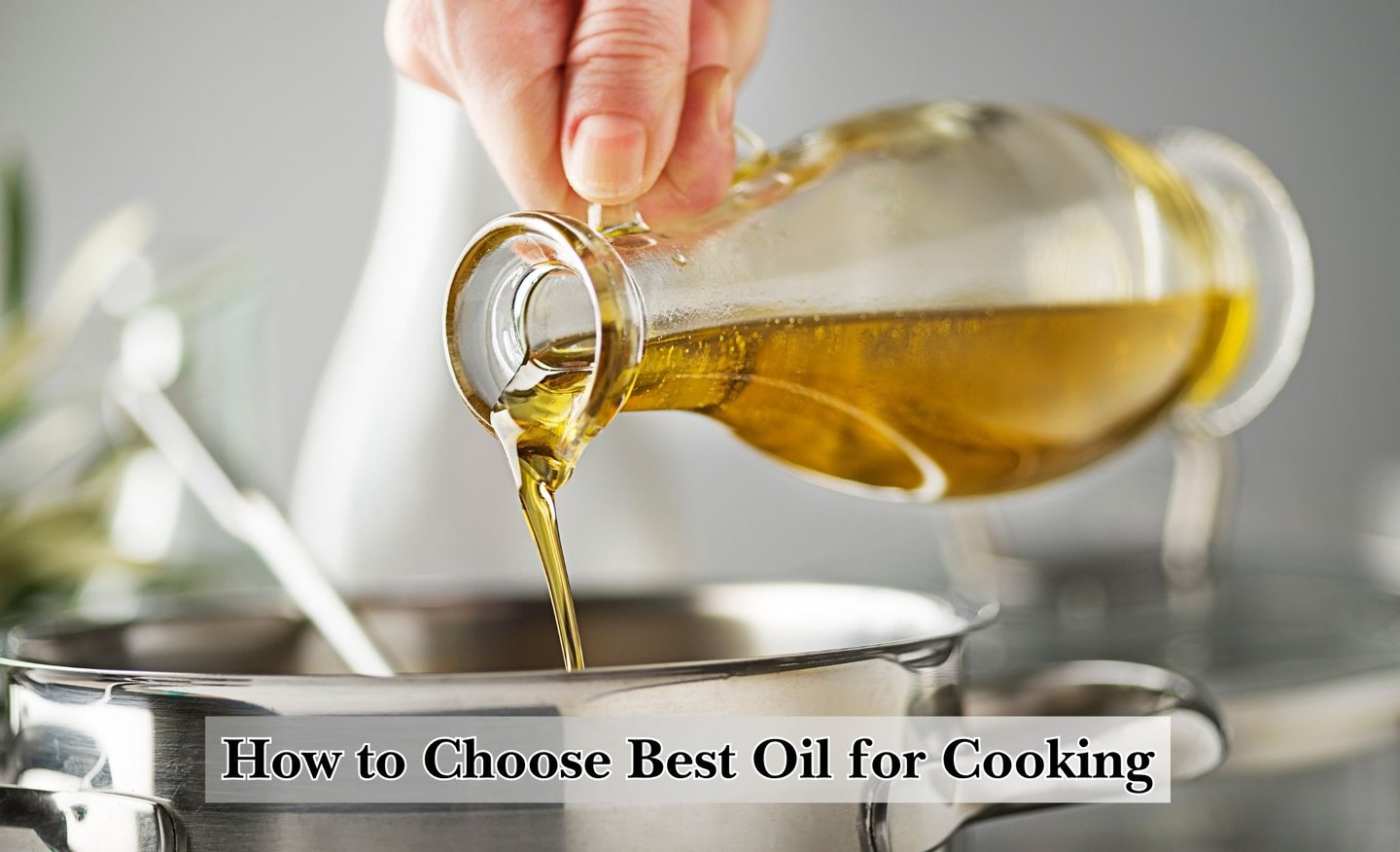

Picking the best oil for cooking makes a real difference in how your food tastes and how it affects your health.
With so many options at the store, it can be tough to figure out which one fits your kitchen and lifestyle.
More people are paying attention to what goes into their meals, especially when it comes to healthy cooking oils.
Knowing how to choose best oil for cooking helps you balance flavor, smoke point, and nutrition, so every dish works for you, not against you.
In this post, you’ll get clear tips to pick the right oil, whether you love high-heat searing or gentle sautéing.
Understanding Cooking Oils and Their Types
When you walk down the cooking oil aisle, each bottle promises something different.
Some promise health benefits, others bring bold flavors, and all vary in how they react to heat.
Learning about the main categories and types of oils is a key step in how to choose best oil for cooking.
Whether you’re stir-frying, roasting, or finishing a salad, the right oil helps your food taste great and align with your nutrition goals.
Let’s break down the basics so you can match the best oil to your cooking style.
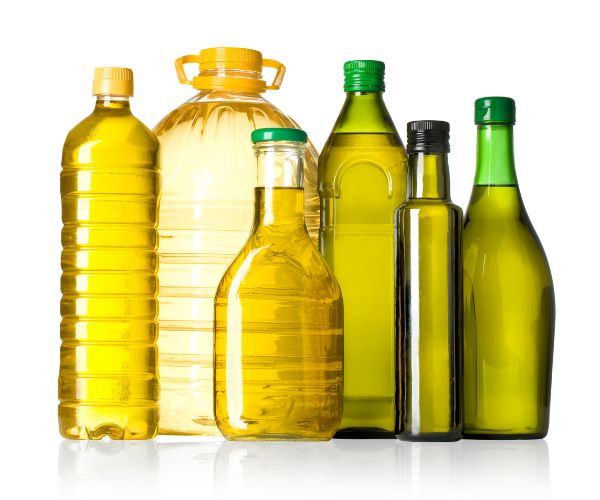

Refined vs. Unrefined Oils
The biggest split in the oil world comes between refined and unrefined oils. Their differences affect everything from nutrients to how your food tastes.
Refined oils are filtered and processed to remove impurities and flavors. This makes them light in taste and able to handle higher heat. Popular refined oils include canola, sunflower, and most vegetable oils. Their high smoke points make them great for frying, roasting, and searing, but they lose some original nutrients and flavors during processing.
Unrefined oils, sometimes called "virgin" or "cold-pressed," skip most processing steps. They keep more of their natural flavor, color, and nutrients. That’s why extra virgin olive oil has such a rich taste and aroma. However, these oils often have lower smoke points, so they work best for dressings, dips, drizzling, or gentle cooking.
Nutrient retention: Unrefined oils hold onto more vitamins, antioxidants, and natural compounds. If you want the most nutrition, choose unrefined for low-heat or cold dishes.
Smoke point: Refined oils win here. When you cook above an oil's smoke point, it can break down and taste burned. Pick your oil based on your cooking method — high heat needs higher smoke points.
Flavor: Bold and nutty flavors come from unrefined oils. Subtle, clean tastes are typical of refined oils.
Getting this balance right helps you pick the perfect oil based on both nutrition and how you want your food to taste.
Common Types of Cooking Oils
Choosing the best oil for cooking often starts with knowing what’s out there. Here are some of the most popular oils, divided into categories with common uses.
Vegetable and Seed Oils:
Canola oil: Mild flavor, high smoke point, good for frying and baking. Neutral enough not to overpower your food.
Sunflower oil: Light taste, high in vitamin E, works for frying, sautéing, and baking.
Soybean oil: Common in processed foods, mild taste, versatile for many cooking styles.
Corn oil: High heat tolerance, mostly used for frying.
Nut Oils:
Avocado oil: Green tint, buttery flavor, high smoke point. Great for grilling, sautéing, and finishing dishes.
Peanut oil: Strong taste, high smoke point, popular for Asian cooking and deep frying.
Walnut oil: Delicate and nutty, used as a finishing oil or in salads.
Olive Oil (Fruit Oil):
Extra virgin olive oil: Rich taste, loaded with heart-healthy fats and antioxidants. Best for drizzling, dressing, or gentle cooking.
Regular olive oil: More refined, higher smoke point, usable for roasting or sautéing.
Animal-Based Fats:
Butter: Adds creamy flavor, low to medium smoke point. Use for baking, sautéing, or anything needing buttery notes.
Ghee: Clarified butter with a nutty aroma, higher smoke point than butter. Perfect for frying and Indian dishes.
Lard and tallow: Traditional cooking fats, high smoke points, bring a unique savory taste to frying and roasting.
Specialty Oils:
Coconut oil: Solid at room temp, tropical flavor. Use refined for higher heat and unrefined (virgin) for more flavor in medium-heat dishes.
Sesame oil: Strong, toasty aroma. Ideal for finishing Asian-inspired recipes.
When thinking about how to choose best oil for cooking, mix and match these options to fit your recipe’s needs.
Using oils from different categories—vegetable, seed, nut, animal—lets you play with taste, nutrition, and texture in every meal.
Keep a few favorites on hand, and you’ll always be ready for what’s next in the kitchen.
Key Factors to Consider When Choosing the Best Oil for Cooking
When figuring out how to choose best oil for cooking, the real differences come down to more than just price or what's popular right now.
Your healthiest pick depends on smoke point, nutritional value, taste, and even dietary needs. Each of these factors shapes how the oil will perform in both recipes and your overall diet.
Here's what to keep in mind so you can make the best call every time you reach for a bottle in your pantry.


Smoke Point and Cooking Methods
The smoke point is the temperature where oil starts to burn and give off smoke. Once past this point, not only does oil lose flavor, but it can also break down and release harmful compounds.
High Smoke Point Oils: These oils, like avocado, canola, and peanut oil, are best for frying, high-heat roasting, and stir-frying. They stand up to intense heat without breaking down.
Medium Smoke Point Oils: Olive oil and sesame oil, for example, work better for sautéing or oven cooking at moderate temps.
Low Smoke Point Oils: Extra virgin olive oil, walnut oil, and flaxseed oil fall into this group. Save these for salad dressings, dips, drizzling over finished dishes, or recipes that need no cooking at all.
Matching the right oil to your cooking method protects flavors and keeps your food as healthy as possible.
Nutritional Profile and Health Benefits
Oils aren’t just about taste and texture; what’s inside matters too. When thinking about how to choose best oil for cooking, look for an oil that fits your approach to healthy eating.
Saturated Fats: Higher in tropical oils (coconut, palm) and animal fats (butter, lard). These add richness but can raise cholesterol if used in excess.
Monounsaturated Fats: Dominant in olive oil, avocado oil, and canola oil. These fats help support heart health.
Polyunsaturated Fats: Common in sunflower, corn, soybean, and grapeseed oils. These include two important types:
Omega-3 fatty acids: Found in flaxseed and walnut oil, known for supporting brain and heart health.
Omega-6 fatty acids: Abundant in most seed oils. Your body needs both omega-3 and omega-6, but too much omega-6 compared to omega-3 may promote inflammation. Strive for balance by mixing oils or choosing those richer in omega-3.
Many oils, especially extra virgin olive oil and unrefined nut oils, also deliver antioxidants (like vitamin E and polyphenols) and vitamins that support whole-body wellness.
Flavor and Culinary Uses
The taste and aroma of an oil can make or break your dish, so think about how much the oil’s flavor matters in your recipe.
Neutral Oils: Canola, vegetable, and most refined oils fade quietly into the background. These are handy for baking, deep frying, or any recipe where you don’t want to taste the oil.
Bold-Flavored Oils: Extra virgin olive oil, sesame oil, coconut oil, peanut oil, and walnut oil each leave their mark. Use these for finishing dishes, salad dressings, marinades, and recipes where their unique notes can shine.
Pairing Oil to Cuisine:
Italian and Mediterranean: Rich olive oils for salads, pasta, and dips.
Asian: Sesame and peanut oils bring dishes to life.
Baking: Neutral oils keep cakes and muffins light and fluffy.
Think about your end result. Want just crispiness? Go neutral. Want to build layers of flavor? Pick bold and aromatic oils.
Dietary Preferences and Restrictions
Personal needs and eating habits play a big part in how to choose best oil for cooking. Thankfully, there are plenty of oils for every situation.
Plant-Based & Vegan: Most oils are plant-based, but skip animal fats like butter, ghee, lard, and tallow. Stick to vegetable, nut, and seed oils.
Allergen-Friendly: If allergies are a worry, avoid nut oils (like peanut or walnut). Instead, reach for canola, sunflower, olive, or refined coconut oil.
Kosher and Halal: Many oils are naturally kosher or halal, but always look for certification on the label to be certain.
Other Restrictions: Coconut oil fits unique diets like paleo and keto, while avocado oil supports both heart-healthy and low-carb eating patterns.
Choosing the best oil starts with knowing your kitchen priorities.
Whether you eat plant-based or avoid certain allergens, there's always an oil that fits what you need and helps keep every meal safe and enjoyable.
Health Considerations: Best Oils for Different Needs
If you want to know how to choose best oil for cooking that truly fits your goals, think about your health needs first.
Each oil brings something different to the table. Some are best for your heart, some for managing weight, while others support popular diets.
Pairing the right oil with your personal health focus makes every meal work for you, not against you.
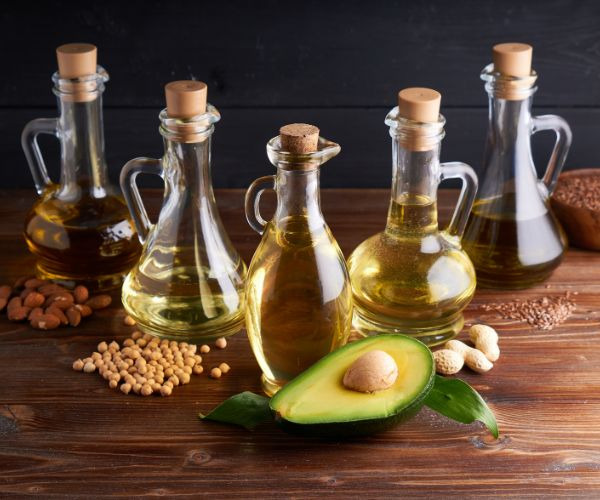

Best Oils for Heart Health
The right oils can be your heart’s best ally. For heart health, pick oils loaded with monounsaturated fats or omega-3 fatty acids.
These healthy fats help lower the bad (LDL) cholesterol and can even raise your good (HDL) cholesterol.
Here are top picks for a healthy heart:
Extra Virgin Olive Oil: Rich in monounsaturated fats and antioxidants. Research consistently connects Mediterranean diets, heavy in olive oil, with lower risks of heart problems.
Avocado Oil: Loaded with the same heart-friendly fats as olive oil, and brings a mild, buttery taste to your kitchen.
Canola Oil: Delivers a good dose of monounsaturated fats and is lower in saturated fat than many choices.
Walnut Oil and Flaxseed Oil: Both are packed with omega-3s, which support a healthy heart and reduce inflammation. Great for finishing dishes and salad dressings.
To keep your heart in good shape, use these oils for drizzling, salad dressings, or finishing vegetables. Save saturated fats like coconut oil, butter, and lard for rare treats.

The Healthiest Cooking Oils
Watch Video...
Best Oils for Weight Management
Controlling calories doesn’t mean you need to skip fat. Instead, focus on how to choose best oil for cooking based on calorie content and how full it makes you feel. Oils are calorie-dense (about 120 calories per tablespoon), so a little goes a long way.
For weight management, consider:
Canola and Light Olive Oil: Both are mild and versatile. Their neutral flavor helps you use less without sacrificing taste. They also contain more monounsaturated fats, which can be more satisfying.
Avocado Oil: While its calorie content is similar, the creamy texture and rich flavor help you use less overall, enhancing satisfaction.
Spray Oils: Perfect for roasting or sautéing with minimal added calories. You control the amount, which helps keep your portions in check.
Tips for using less oil:
Measure, don’t pour. A small spoon is your friend.
Try oil sprays. These coat pans and veggies lightly and evenly.
Pair oils with fiber-rich foods. Healthy fats slow digestion, keeping you full longer. Drizzle over beans, salads, or hearty whole grains.
Best Oils for Specialized Diets
Sticking to a specific eating plan adds another layer to how to choose best oil for cooking. Whether you’re low-carb, plant-based, or gluten-free, there’s an oil that fits your routine.
Keto Diet:
Coconut Oil: High in healthy saturated fats (MCTs), a favorite for those deep into ketosis.
Avocado Oil and Extra Virgin Olive Oil: Both are excellent picks for high-fat, low-carb meals.
Paleo Diet:
Avocado, Coconut, and Olive Oil: Mimic the fats favored in whole-food, ancestral diets.
Animal Fats (like ghee or tallow): Clean, grass-fed sources work for strict paleo followers.
Vegan and Plant-Based:
Olive Oil, Sunflower Oil, Canola Oil, and Avocado Oil: All are 100 percent plant-based and widely available.
Flaxseed and Walnut Oil: Both offer omega-3s, important for vegans who don’t eat fish.
Gluten-Free Diet:
Nearly all pure oils are naturally gluten-free.
Check for flavor blends or infused oils just in case—some contain additives.
Other Diets (like Whole30 or Mediterranean):
Extra Virgin Olive Oil: Staples for Mediterranean and Whole30 meals due to clean ingredients and beneficial fats.
Sesame Oil: Great addition to Asian-inspired gluten-free or vegan dishes, just use sparingly due to strong flavor.
Matching your oil to your diet means looking at both the nutritional benefits and any extra needs your eating plan has.
Always check the label for additives or cross-contamination if you have allergies or strict dietary restrictions.
From heart support to making your favorite diet work, picking the right oil shapes your meals and your health for the better.
Sustainability and Cost: Practical Considerations
When figuring out how to choose best oil for cooking, it’s smart to think about more than just taste and health.
The way oils are produced, where they come from, and how much they cost can shape your decision.
Everyone wants their food to support both a healthier life and a healthier planet, without breaking the bank.
Let’s look deeper into what matters when you weigh sustainability and cost together.


Sustainable and Ethical Sourcing
Choosing sustainable oils isn’t just a trend—it shapes the future of our food system. When you scan labels, keep an eye out for a few green flags that truly matter:
Organic Certification: Oils labeled organic come from crops grown without harmful pesticides and synthetic fertilizers. This supports cleaner soil and water while limiting chemical residues in your food.
Non-GMO: Non-GMO oils come from seeds and plants that haven't been genetically modified. Many people choose non-GMO for peace of mind, but it also supports biodiversity in farming.
Fair Trade Certified: This stamp means workers behind the oil earn fair wages and work in better conditions. Fair trade oils often come from small-scale farmers, supporting whole communities.
Locally Sourced: Picking oils made close to home cuts down on emissions from long transport. Local oils, like extra virgin olive oil from nearby producers, often taste fresher and create less pollution.
The environmental impact of these choices is real:
Organic and fair trade farms usually treat their land with care. They support soil health and protect wildlife.
Non-GMO and organic oils help shape a more resilient food supply, less reliant on big chemical companies.
Local sourcing not only lowers your carbon footprint but also builds stronger regional economies.
If you care about where your food comes from, picking organic, non-GMO, or fair trade oils lets your kitchen choices match your values. You’ll taste the difference and feel good about your impact.
Balancing Budget with Quality
Great oils don’t have to drain your wallet. While premium labels grab attention, there are smart ways to balance price, health, and flavor:
Shop Store Brands: Many grocery brands offer high-quality oils at a lower price than fancy imports—especially for staples like canola, sunflower, or basic olive oil.
Buy in Bulk: Larger bottles are often cheaper per ounce, but only buy what you’ll use in a couple of months. Oils spoil when they sit too long.
Go Seasonal and Local: In-season, local oils can be the freshest and most affordable. Visit your farmers market or local co-op for good deals on olive or sunflower oils straight from the source.
Rotate Oils: Keep one or two premium oils for salad dressings or finishing. For daily cooking and frying, use more affordable options with a neutral taste and high smoke point.
Watch for Sales: Oils have a long shelf life (several months unopened), so stock up when your favorites are discounted.
A few tips to stretch your oil budget without dropping quality:
Use strong-flavored oils, like sesame or walnut, for finishing dishes. A little goes a long way.
For frying or baking, rely on wallet-friendly picks like canola or pure olive oil.
Always compare the ingredient list and sourcing on the label—not just the price or brand.
Smart shopping helps you get the best value, so every dish supports both your tastebuds and your wallet.
When deciding how to choose best oil for cooking, remember that both ethical choices and budget finds can have a place in your kitchen.
The key is staying informed, so you make purchases that feel right for your recipes and your values.
Conclusion
Choosing the best oil for cooking comes down to three things: your health needs, the flavors you love, and what fits your budget.
Keep smoke point, fat type, and sourcing in mind, then let your taste buds guide you. Try new oils for different dishes and don’t be afraid to swap brands or blends if you find a better match for your cooking style.
Experiment with a few staples, then build a routine that works for you. Every kitchen is different—there’s no single perfect oil, just what suits your life right now.
Thanks for reading, and share your favorite tips or oils below.
Your feedback helps build a smarter, tastier, and healthier kitchen for everyone.
Southern Spice Homestyle Delights © 2025. All rights reserved.
Address
Rayville, La 71269
Want more from Southern Spice?


Get recipes, cooking inspiration, and exclusive information right to your inbox!
Categories

